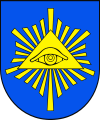 Wilamowice (German: Wilmesau) is a small town in southern Poland in Bielsko County, Silesian Voivodeship (since 1999, previously in Bielsko-Biała Voivodeship, 1975-1998). The endangered language of Wymysorys is spoken here by about 70 native speakers, the majority of them elderly. The language was the main one of the town until the early communist period (1945-1956), when authorities repressed it.
Wilamowice (German: Wilmesau) is a small town in southern Poland in Bielsko County, Silesian Voivodeship (since 1999, previously in Bielsko-Biała Voivodeship, 1975-1998). The endangered language of Wymysorys is spoken here by about 70 native speakers, the majority of them elderly. The language was the main one of the town until the early communist period (1945-1956), when authorities repressed it.
Mainly Jews from nearby Skoczów used this cemetery. Jewish presence began in Skoczów during the Middle Ages. Jewish merchants were in Skoczów in the 15th century on the trade route from Wroclaw to Krakow and then to Hungary, the first Jew to settle permanently in Skoczów was Jacob Abraham Singer, who purchased a "free house" at the castle from Charles Sobka in 1700. Jacob Singer and his family were probably the only Jewish settlers in the city. On January 10, 1713 Charles VI issued an order of tolerance, permitting Jews to live in Silesia for paying a special "tolerant tax." According to the census of 1737, beside Jacob Singer Israel, Jacob, and Aaron Lobel also paid the tax. In 1752, 27 Jews, the majority poor, sold alcohol in an arenda or did small trade. They had their own butcher and a teacher. Their community was subject to the kahal Skoczów in Cieszyn. The local Jewish cemetery on ul Hażlaskiej was used. During the reign of Emperor Joseph II, freedom of religion and civil rights were given to all. Jewish population grew here. The Wałowa Street house of prayer gave way to a synagogue in 1853 at the corner of the present ul Mickiewicza and Cieszyńskiej. For the first forty years of its existence, they were subject to the rabbi/kahal in Cieszyn. The hide factory owner, David Spitzer, encouraged independence. The first step was the cemetery in Wilamowicach in 1891. In 1890, 586 Jews lived in Skoczów in the streets all around Bielska, Ustrońskiej, Mennicza, Mickiewicz and the market. On December 21, 1892, the National Government in Opava in Bielsko Starost approved a new Jewish community in Skoczów. In the 1930s, anti-Semitism encouraged some of the wealthier Jews to immigrate. The Germans entered the city on September 2, 1939 and took over the Jewish shops and factories, synagogue and cemetery in Wilamowice. On October 27, Jewish men between ages 16 and 60 were deported to work in Rzeszów. About 140 other Jews in the city, mostly women, children and the elderly, were gathered in the house at ul. Mickiewicza 42 (15 people to a room); and in mid-1940 were taken to the nearby ghetto in Zawiercie Łazach. After the war, few survived. Leopold Rosenthal, Zygmunt Weitraub, Hugon Tobiasz and Maksymilian Metzendorf returned to Skoczów, but immigrated within about ten years..
Before this cemetery existed, the Jews used the cemetery in Cieszyn. In 1891, this cemetery was establishing three kilometers east of Skoczów. The oldest preserved gravestone is that of Zabarski, who died on January 24, 1891. The beit tahara and caretaker house were built. Originally the cemetery had a wooden fence, replaced in 1910 with a metal mesh fence and concrete entrance gate. The cemetery was in use until the outbreak of WWII with 300 burials from Jews from Skoczów, Ustroń, Vistula, Pruchnej, Brenna, and other smaller towns. The granite and concrete gravestones with less of sandstone and limestone have mostly Hebrew inscriptions with minor text in German or Polish. Rich symbolism was that traditional on Jewish gravestones (palms, pitcher, candle, crown, palm tree, Mogen David). During German occupation, the cemetery was devastated. The gravestones were sold to Betoniarni Jeikner Company (Schanzer Brothers before the war), They were sold to masons for reuse. After the war the Jews who returned to Skoczów took family gravestones found at Betoniarni back to the cemetery. Other gravestones awaited Autumn 1958 when Leopold Rosenthal intervened with The Bureau of the National Council of the City that ordered Skoczów Plants Products "Lastrico" (Ex-factory Schanzer Bros) to return the gravestones. Leopold Rosenthal also placed a new fence. After immigration of the last Jews, the cemetery fell into disrepair. A 1970s plan to liquidate the cemetery and build a big park and cultural center was not implemented. The beit tahara was demolished. Today, foundations and shallow impressions are all that remain. The cemetery area was very untidy until 1996 when survivors and their descendants (Filippo Alvino from Brussels), Eternal Memorial Foundation and Jack Proszyka) cleaned the cemetery. The 54 surviving matzevot became a lapidarium in a double circle with a Mogen David and a monument commemorating the victims of the Holocaust. The unveiling was in June 1997. Burial list. Video. [July 2009]
